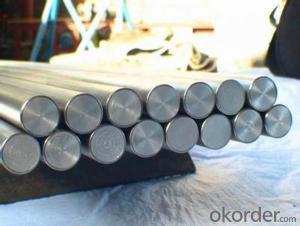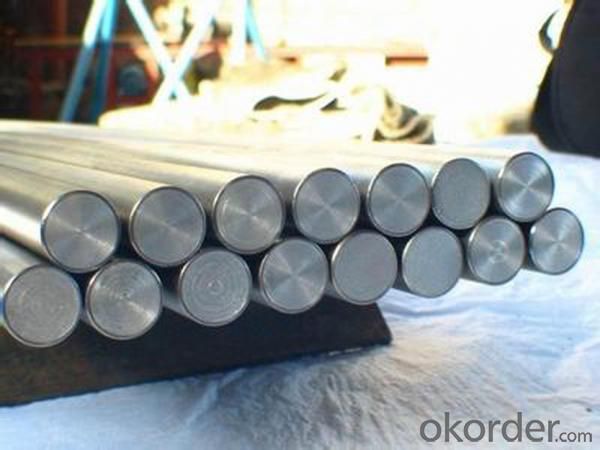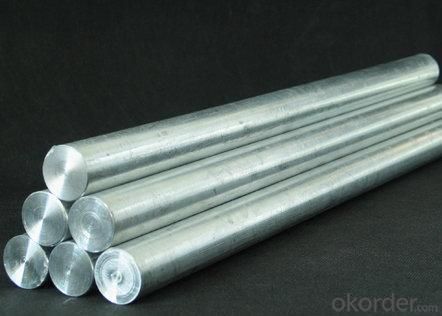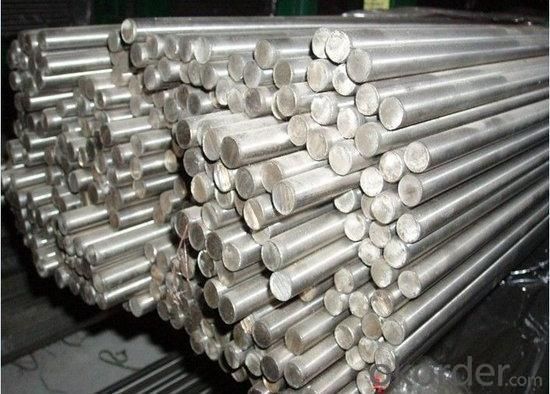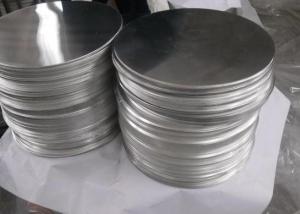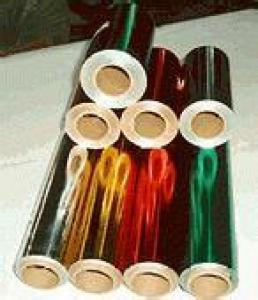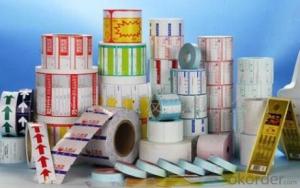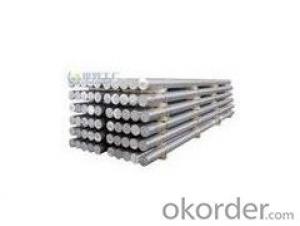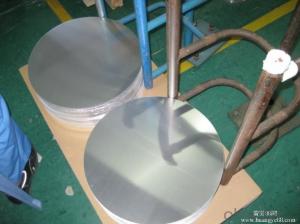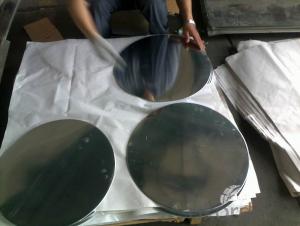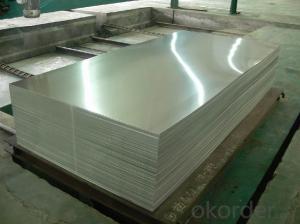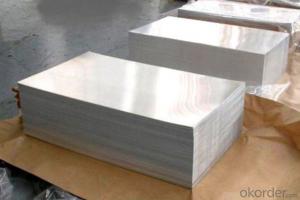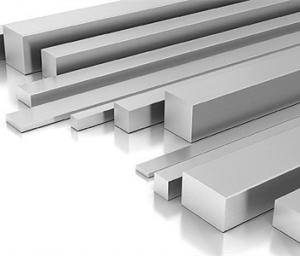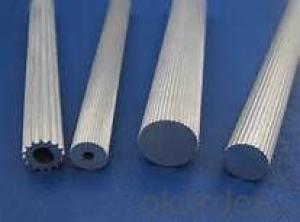aluminium bars wih a wide range of properties
- Loading Port:
- Shanghai
- Payment Terms:
- TT OR LC
- Min Order Qty:
- 800 m.t.
- Supply Capability:
- 3000 m.t./month
OKorder Service Pledge
OKorder Financial Service
You Might Also Like
Product description:
Aluminium alloys with a wide range of properties are used in engineering structures. Alloy systems are classified by a number system (ANSI) or by names indicating their main alloying constituents (DIN and ISO).
The strength and durability of aluminium alloys vary widely, not only as a result of the components of the specific alloy, but also as a result of heat treatments and manufacturing processes. A lack of knowledge of these aspects has from time to time led to improperly designed structures and gained aluminium a bad reputation.
One important structural limitation of aluminium alloys is their fatigue strength. Unlike steels, aluminium alloys have no well-defined fatigue limit, meaning that fatigue failure eventually occurs, under even very small cyclic loadings. This implies that engineers must assess these loads and design for a fixed life rather than an infinite life.
Another important property of aluminium alloys is their sensitivity to heat. Workshop procedures involving heating are complicated by the fact that aluminium, unlike steel, melts without first glowing red. Forming operations where a blow torch is used therefore require some expertise, since no visual signs reveal how close the material is to melting. Aluminium alloys, like all structural alloys, also are subject to internal stresses following heating operations such as welding and casting. The problem with aluminium alloys in this regard is their low melting point, which make them more susceptible to distortions from thermally induced stress relief. Controlled stress relief can be done during manufacturing by heat-treating the parts in an oven, followed by gradual cooling—in effect annealing the stresses.
The low melting point of aluminium alloys has not precluded their use in rocketry; even for use in constructing combustion chambers where gases can reach 3500 K. The Agena upper stage engine used a regeneratively cooled aluminium design for some parts of the nozzle, including the thermally critical throat region.
Another alloy of some value is aluminium bronze (Cu-Al alloy).
Aluminium foil acts as a total barrier to light and oxygen (which cause fats to oxidise or become rancid), odours and flavours, moistness, and germs, it is used broadly in food and pharmaceutical packaging. The purpose of aluminium is to make long-life packs (aseptic processing|aseptic packaging) for drinks and dairy goods, which allows storing without refrigeration. Aluminium foil containers and trays are used to bake pies and to pack takeaway meals, ready snacks and long life pet foods.
Aluminium foil is widely sold into the consumer market, often in rolls of 500 mm (20 in) width and several metres in length.It is used for wrapping food in order to preserve it, for example, when storing leftover food in a refrigerator (where it serves the additional purpose of preventing odour exchange), when taking sandwiches on a journey, or when selling some kinds of take-away or fast food. Tex-Mex restaurants in the United States, for example, typically provide take-away burritos wrapped in aluminium foil.
Aluminium foils thicker than 25 μm (1 mil) are impermeable to oxygen and water. Foils thinner than this become slightly permeable due to minute pinholes caused by the production process.
Aluminium foil has a shiny side and a matte side. The shiny side is produced when the aluminium is rolled during the final pass. It is difficult to produce rollers with a gap fine enough to cope with the foil gauge, therefore, for the final pass, two sheets are rolled at the same time, doubling the thickness of the gauge at entry to the rollers. When the sheets are later separated, the inside surface is dull, and the outside surface is shiny. This difference in the finish has led to the perception that favouring a side has an effect when cooking. While many believe that the different properties keep heat out when wrapped with the shiny finish facing out, and keep heat in with the shiny finish facing inwards, the actual difference is imperceptible without instrumentation.The reflectivity of bright aluminium foil is 88% while dull embossed foil is about 80%.
We provide a full range of precision aluminum strip for almost any application. We produce aluminum strip in a wide variety of alloys, including clad composites. Our aluminum strip can be produced in standard dimensions or custom made to your special requirements. We produce both imperial and metric units. We manufacture in compliance with the main international specifications, and tighter tolerances or custom tempers are available upon request. We offer various surface conditions, custom finishes (painting, anodizing, embossing), special processing, and multiple packaging options to meet our customer's unique requirements. The following is a summary of our capabilities.
Manufactured in compliance with the main international specifications and standards, including: Aluminum Association, ASTM, EN, and DIN.
We can also manufacture in compliance with other international standards including:ASME, SAE, AMS, AWS, FED, MIL, QQ, ISO, BS, AFNOR, JIS and GOST.
Manufactured in compliance with the main international specifications and standards.
Tighter tolerances are available upon request.
Aluminium (or aluminum; see spelling differences) is a chemical element in the boron group with symbol Al and atomic number 13. It is a silvery white, soft, ductile metal. Aluminium is the third most abundant element (after oxygen and silicon), and the most abundant metal in the Earth's crust. It makes up about 8% by weight of the Earth's solid surface. Aluminium metal is so chemically reactive that native specimens are rare and limited to extreme reducing environments. Instead, it is found combined in over 270 different minerals.The chief ore of aluminium is bauxite.
Aluminium is remarkable for the metal's low density and for its ability to resist corrosion due to the phenomenon of passivation. Structural components made from aluminium and its alloys are vital to the aerospace industry and are important in other areas of transportation and structural materials. The most useful compounds of aluminium, at least on a weight basis, are the oxides and sulfates.
Despite its prevalence in the environment, no known form of life uses aluminium salts metabolically. In keeping with its pervasiveness, aluminium is well tolerated by plants and animals. Owing to their prevalence, potential beneficial (or otherwise) biological roles of aluminium compounds are of continuing interest.
The earliest citation given in the Oxford English Dictionary for any word used as a name for this element is alumium, which British chemist and inventor Humphry Davy employed in 1808 for the metal he was trying to isolate electrolytically from the mineral alumina. The citation is from the journal Philosophical Transactions of the Royal Society of London: "Had I been so fortunate as to have obtained more certain evidences on this subject, and to have procured the metallic substances I was in search of, I should have proposed for them the names of silicium, alumium, zirconium, and glucium."
Davy settled on aluminum by the time he published his 1812 book Chemical Philosophy: "This substance appears to contain a peculiar metal, but as yet Aluminum has not been obtained in a perfectly free state, though alloys of it with other metalline substances have been procured sufficiently distinct to indicate the probable nature of alumina."[69] But the same year, an anonymous contributor to the Quarterly Review, a British political-literary journal, in a review of Davy's book, objected to aluminum and proposed the name aluminium, "for so we shall take the liberty of writing the word, in preference to aluminum, which has a less classical sound."
The -ium suffix conformed to the precedent set in other newly discovered elements of the time: potassium, sodium, magnesium, calcium, and strontium (all of which Davy isolated himself). Nevertheless, -um spellings for elements were not unknown at the time, as for example platinum, known to Europeans since the 16th century, molybdenum, discovered in 1778, and tantalum, discovered in 1802. The -um suffix is consistent with the universal spelling alumina for the oxide (as opposed to aluminia), as lanthana is the oxide of lanthanum, and magnesia, ceria, and thoria are the oxides of magnesium, cerium, and thorium respectively.
The aluminum spelling is used in the Webster's Dictionary of 1828. In his advertising handbill for his new electrolytic method of producing the metal in 1892, Charles Martin Hall used the -um spelling, despite his constant use of the -ium spelling in all the patents[58] he filed between 1886 and 1903. It has consequently been suggested[by whom?] that the spelling reflects an easier-to-pronounce word with one fewer syllable, or that the spelling on the flyer was a mistake.[citation needed] Hall's domination of production of the metal ensured that aluminum became the standard English spelling in North America.
- Q:What knives do you need for cutting aluminum 2A12 bars?
- Common machine tools using high-speed steel cutting tools are more common. For example, when the need of high speed cutting in CNC machine tool machining, hard alloy coating M is widely used, but if possible using the tool of the PCD class, you can use high speed and good surface quality, but the drawback is that the cutting depth can not be too large, or easy to damage the tool.
- Q:What kind of saw blades can be cut?
- Selection of saw blade thickness stability from the blade work and cut materials to consider. With the diameter of the saw cutting equipment and cutting workpiece thickness. Kunshan Feng rui1 tool factory has focused on the design and development of ultra-thin blade, including the boss saw the use effect of ultra-thin can provide lower production cost and efficiency for customers.Feng Jinrui is happy to answer it for you. Welcome to consult Feng rui1 tool.
- Q:Aluminum bar flaw detector which good?
- Consider Suzhou diamond electronic technology limited company, engaged in the series of eddy current flaw detector, sorting instrument, ultrasonic flaw detector, tube bar, metal parts, auto parts R & D automatic flaw detection system of production, provide a complete detection method and process of product quality to meet user requirements to improve the quality of all the rapid detection for customers, products widely for electric power, aerospace, military industry, metallurgy, 112379.jpg machinery manufacturing industry. Especially in the pipe, rod, wire and other metal parts, auto parts nondestructive testing in the leading position in china.
- Q:Which of the aluminum and aluminum bars of the same length bear more force?
- Aluminum sheet refers to the rectangular plate made of aluminium ingot rolled and divided into pure aluminum plate, alloy aluminum plate, thin aluminum plate, middle thick aluminum plate and pattern aluminum plate.
- Q:What should be used in grinding wheel and grinding fluid. Please enlighten master.Because the aluminum rod is soft in the grinding process of grinding cutting aluminum is easy to stick to the surface of the wheel, causing the surface blackening of aluminium rods or rough, we have tried what you said, not the key to solve the problem, I can have the method of experts can provide professional.We are processing the printer core shaft of the company, the product's high precision polishing may not be realized.
- The key method of aluminum rod grinding you. My Baidu space have introduced mill aluminum bar, you can go and see.
- Q:What are the requirements of industrial profiles for aluminum bars?
- Profiled material depends on the customer's material requirements to deal with! The material requirements of industrial profiles depend on the scope and requirements of this profile!
- Q:Aluminum rod outside diameter 50mm height 200mm how to calculate weight?
- The volume multiplied by the density is the method of calculating the weight of the objectThe volume of the cylinder is V = D^2* PI /4*H. In the formula, D is the diameter of the round bar, and H is the length of the round bar. The density of the aluminum needs to be checked by the relevant manual, and the result can be obtained
- Q:What I do is export, and like this, the tax check will be checked every time. Is there a better export HS code that meets the product characteristics?
- There is a pure aluminum or aluminum alloy:Pure aluminum: 7604101000 tariff rate 5%Aluminum alloy: 7604291091, section perimeter, etc. / greater than 210 mm 5%7604291099 the circumference of the section is less than 210 mm 5%
- Q:Chemical composition of aluminium rods
- Aluminum Al: marginSilicon Si:0.20 ~ 0.60Copper Cu:0.10Magnesium Mg:0.45 ~ 0.9Zinc Zn:0.10Manganese Mn:0.10Titanium Ti:0.10Chromium Cr:0.10Iron Fe:0.35
- Q:I know that aluminum plate can be punched, aluminum material can be forged and cast, but I do not know what this extrusion means Profiles and god horse? Can I say the next process?.. Thank you
- Aluminum rod extrusion into aluminum by hot extrusion process, the process is as follows: firstly, the electrolytic aluminum ingots adding alloy elements were cast into rods, will cut into long rod short rod, short rod heating, but also to die will be used by the heating rod and the extrusion machine for heating the aluminum extrusion molding, if using T5 can use the machine before the delivery, then the profile of air cooling, stretching and straightening, cutting to length, frame, finally, artificial aging. If the aluminum profile needs to be anodized, electrophoresis, painting, powder spraying and other surface treatment, and then the corresponding surface treatment, which is the aluminum production process. It can be simply summarized as follows: - melting - casting - aluminum electrolytic aluminum rod sawing - aluminum bar heating - hot extrusion molding - air cooling - stretching and straightening, cutting to length, artificial aging, surface treatment (anodizing, electrophoretic coating, powder coating etc.).
1. Manufacturer Overview |
|
|---|---|
| Location | |
| Year Established | |
| Annual Output Value | |
| Main Markets | |
| Company Certifications | |
2. Manufacturer Certificates |
|
|---|---|
| a) Certification Name | |
| Range | |
| Reference | |
| Validity Period | |
3. Manufacturer Capability |
|
|---|---|
| a)Trade Capacity | |
| Nearest Port | |
| Export Percentage | |
| No.of Employees in Trade Department | |
| Language Spoken: | |
| b)Factory Information | |
| Factory Size: | |
| No. of Production Lines | |
| Contract Manufacturing | |
| Product Price Range | |
Send your message to us
aluminium bars wih a wide range of properties
- Loading Port:
- Shanghai
- Payment Terms:
- TT OR LC
- Min Order Qty:
- 800 m.t.
- Supply Capability:
- 3000 m.t./month
OKorder Service Pledge
OKorder Financial Service
Similar products
New products
Hot products
Hot Searches
Related keywords
